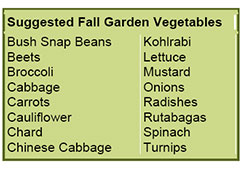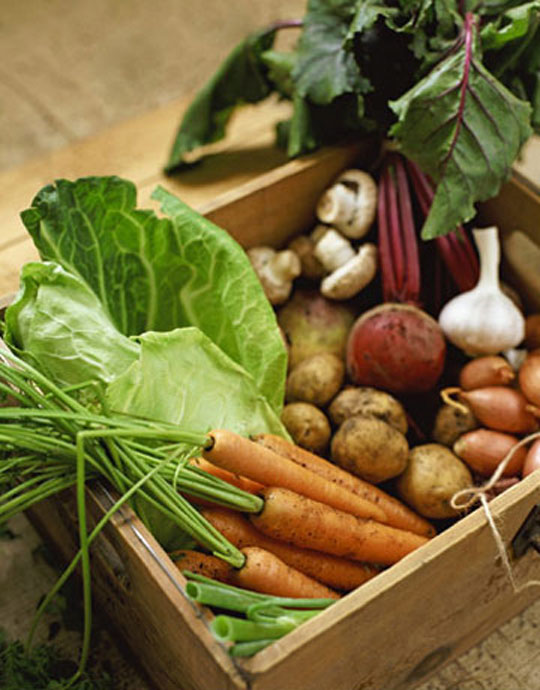Still Time To Plant Those Fall Vegetables
October 25, 2009
Football may be heating up, but the temperatures are going to start cooling down. Just because summer is drawing to a close doesn’t mean that the
vegetable gardener needs to put up his or her hoe and dream of the first red tomato in 2010. Now is the time to start growing some fall and winter vegetables.
 Strike while the iron is hot—seed beets, collards, mustard, turnips, snap beans, broccoli, cabbage and cauliflower as soon as possible. Bulbs like shallots and green onion can also be planted. You can also transplant broccoli, cauliflower and cabbage to get a jump start. Plant garlic in October. Consider interval plantings of the same crop to prolong the season. If you plant a row of cabbage now, think about planting another short row in a few weeks to ensure you have a longer season.
Strike while the iron is hot—seed beets, collards, mustard, turnips, snap beans, broccoli, cabbage and cauliflower as soon as possible. Bulbs like shallots and green onion can also be planted. You can also transplant broccoli, cauliflower and cabbage to get a jump start. Plant garlic in October. Consider interval plantings of the same crop to prolong the season. If you plant a row of cabbage now, think about planting another short row in a few weeks to ensure you have a longer season.
When you transplant some of the more the more tender plants that have been kept under shady areas, you should think about protecting them from the bright sun for a few days and be prepared to water the transplants until they become established. If you seed your row too thick, if you gently pull up the plants, you can sometimes salvage them and put them in another row. Be prepared to give them a little shade and moisture because the root system isn’t well developed.
 A fall garden is open to attack by insects and diseases just as the summer garden. Worms (cabbage loopers and imported cabbage moths) are serious problems on fall cabbage, cauliflower, broccoli, and collards. Control these leaf-eating worms with one of the biological sprays with Bt (Bacillus thuringiensis). It should be reapplied weekly because it will break down in sunlight. Bt acts by producing proteins (deltaendotoxin, the “toxic crystal”) that reacts with the cells of the gut lining of susceptible insects. These Bt proteins paralyze the digestive system, and the infected insect stops feeding within hours. Bt-affected insects generally die from starvation, which can take several days (click here).
A fall garden is open to attack by insects and diseases just as the summer garden. Worms (cabbage loopers and imported cabbage moths) are serious problems on fall cabbage, cauliflower, broccoli, and collards. Control these leaf-eating worms with one of the biological sprays with Bt (Bacillus thuringiensis). It should be reapplied weekly because it will break down in sunlight. Bt acts by producing proteins (deltaendotoxin, the “toxic crystal”) that reacts with the cells of the gut lining of susceptible insects. These Bt proteins paralyze the digestive system, and the infected insect stops feeding within hours. Bt-affected insects generally die from starvation, which can take several days (click here).
Fall vegetables need fertilizer just as much as spring and summer vegetables. Don’t count on the fertilizer applied in spring to supply fertilizer needs of vegetables planted in late summer and fall. Fertilize before planting and side-dress as needed.
Finally, if you really want to take a break prior to the spring crops, at least clean up debris and put your stakes and poles away. The Fall is good time to take a soil test and put out lime for it to have enough time to react for your spring crop. You could even get a row or two ready to plant potatoes come late
January/early February.
Need more information? Call the Escambia County Extension office at (850) 475-5230.
Submitted by the Escambia County Extension office.
Comments
2 Responses to “Still Time To Plant Those Fall Vegetables”



REGARDING:
“These Bt proteins paralyze the digestive system, and the infected insect stops feeding within hours. Bt-affected insects generally die from starvation, which can take several days ”
People for The Ethical Treatment of Insects will not be pleased.
Still…… I do love mustard greens
Thanks for the heads us…My kids were not happy when the summer garden died off. I think we will have a lemonade stand or something to raise money to replant the winter community garden. That will help out on everyones grocery bill as well as give them something to do during the fall months. Thanks for reminding me that spring/summer is not the ONLY time to plant!